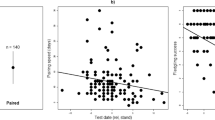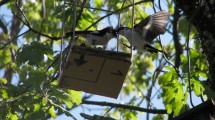Abstract
In intrasexual conflicts, contestants can rely on relative or absolute size of status badges to mediate aggressive behavior. Most studies focus on the response of focal animals to variation in status badges of their competitors; few have simultaneously considered the traits of both participants under experimental conditions. By simulating territorial intrusions, we tested the importance of two sexual traits [forehead patch size (FPS) and wing patch size (WPS)] in territorial behavior of males in a Hungarian population of the collared flycatcher, Ficedula albicollis. We presented a stimulus male to an unpaired resident male to examine whether the characteristics of the territory owner or those of the challenger were associated with the latency of the first attack of the owner, which is a good predictor of the territorial behavior in general. WPS of the stimulus male was a significant determinant of the latency of the first attack, as males with a larger WPS elicited quicker attacks from the residents than males with a small WPS. From the residents’ perspective, age appeared to influence their territorial behavior, as yearlings had shorter attack latencies than older males. Additionally, latency could be considered an individual-specific attribute because it varied consistently among males, even when the WPS of the stimulus male was controlled, and it was associated with pairing success. Contrary to findings in a Swedish population, FPS seemed to be unimportant in male–male competition in our population, which suggests population differences in the role of the two plumage traits. Our results indicate that in a territorial conflict, the characteristics of both participants are important.



Similar content being viewed by others
References
Andersson M (1994) Sexual selection. Princeton University Press, Princeton, NJ
Badyaev AV, Hill GE (2000) Evolution of sexual dichromatism: contribution of carotenoid- versus melanin-based coloration. Biol J Linn Soc 69:153–172
Beletsky LD, Orians GH (1987) Territoriality among male red-winged blackbirds. 2. Removal experiments and site dominance. Behav Ecol Sociobiol 20:339–349
Beletsky LD, Orians GH (1989) Territoriality among male red-winged blackbirds. III. Testing hypotheses of territorial dominance. Behav Ecol Sociobiol 24:333–339
Beletsky LD, Orians GH (1993) Factors affecting which male red-winged blackbirds acquire territories. Condor 955:782–791
Butcher GS, Rohwer S (1989) The evolution of conspicuous and distinctive coloration in birds. Curr Ornithol 6:51–108
Cramp S, Perrins CM (1993) The birds of the Western Palearctic, vol VII. Flycatchers to shrikes. Oxford University Press, Oxford
Crawley MJ (1993) GLIM for ecologists. Blackwell Scientific Publications, Oxford
Crowder MJ, Hand DJ (1990) Analysis of repeated measures. Chapman & Hall, New York
Dawkins R, Krebs JR (1978) Animal signals: information or manipulation? In: Krebs JR, Davies NB (eds) Behavioural ecology: an evolutionary approach. Sinauer Associates, Sunderland, Massachusetts
Dufour KW, Weatherhead PJ (1998) Bilateral symmetry and social dominance in captive male red-winged blackbirds. Behav Ecol Sociobiol 42:71–76
Eckert CG, Weatherhead PJ (1987) Competition for territories in red-winged blackbirds: is resource-holding potential realized. Behav Ecol Sociobiol 20:369–375
Forstmeier W, Kempenaers B, Meyer A, Leisler B (2002) A novel song parameter correlates with extra-pair paternity and reflects male longevity. Proc R Soc Lond B 269:1479–1485
Garamszegi LZ, Møller AP, Török J, Michl G, Péczely P, Richard M (2004) Immune challenge mediates vocal communication in a passerine bird: an experiment. Behav Ecol 15:148–157
Garant D, Sheldon BC, Gustafsson L (2004) Climatic and temporal effects on the expression of secondary sexual characters: genetic and environmental components. Evolution 58:634–644
Gil D, Slater PJB (2000) Song organisation and singing patterns of the willow warbler, Phylloscopus trochilus. Behaviour 137:759–782
Grafen A, Hails RS (2002) Modern statistics for the life sciences. Oxford University Press, Oxford
Groothuis TGG, Carere C (2005) Avian personalities: characterization and epigenesis. Neurosci Biobehav Rev 29:137–150
Gustafsson L, Nordling D, Andersson MS, Sheldon BC, Qvarnström A (1994) Infectious diseases, reproductive effort and the cost of reproduction in birds. Philos Trans R Soc Lond B 346:323–331
Gustafsson L, Qvarnström A, Griffith SC (1995) Trade-offs between life-history traits and a secondary sexual character in male collared flycatchers. Nature 375:311–313
Hansen AJ, Rohwer S (1983) Coverable badges in intramale territorial disputes. Am Zool 23:932–932
Hansen AJ, Rohwer S (1986) Coverable badges and resource defense in birds. Anim Behav 34:69–76
Hegyi G, Török J, Tóth L (2002) Qualitative population divergence in proximate determination of a sexually selected trait in the collared flycatcher. J Evol Biol 15:710–719
Hyman J, Hughes M, Searcy WA, Nowicki S (2004) Individual variation in the strength of territory defense in male song sparrows: correlates of age, territory tenure, and neighbor aggressiveness. Behaviour 141:15–27
Jackson WM (1991) Why do winners keep winning. Behav Ecol Sociobiol 28:271–276
Jakobsson S (1988) Territorial fidelity of willow warbler (Phylloscopus trochilus) males and success in competition over territories. Behav Ecol Sociobiol 22:79–84
Järvi T, Bakken M (1984) The function of the variation in the breast stripe of the great tit (Parus major). Anim Behav 32:590–596
Kose M, Møller AP (1999) Sexual selection, feather breakage and parasites: the importance of white spots in the tail of the barn swallow (Hirundo rustica). Behav Ecol Sociobiol 45:430–436
Krebs JR (1982) Territorial defense in the great tit (Parus major): do residents always win? Behav Ecol Sociobiol 11:185–194
Lack D (1946) The life of the robin, revised edn. H. F. and G. Witherby, London
Lack D (1968) Ecological adaptations for breeding in birds. Methuen, London
Maynard-Smith J (1982) Evolution and the theory of games. Cambridge University Press, Cambridge
Maynard-Smith J, Harper DGC (1988) The evolution of aggression: can selection generate variability? Philos Trans R Soc Lond B 319:557–570
Maynard-Smith J, Parker GA (1976) The logic of asymmetric contests. Anim Behav 24:159–175
Mays HL, Hopper KR (2004) Differential responses of yellow-breasted chats, Icteria virens, to male and female conspecific model presentations. Anim Behav 67:21–26
Møller AP (1986) Mating system among European passerines: a review. Ibis 128:234–250
Morris L (1975) Effect of blackened epaulets on the territorial behavior and breeding success of male red-winged blackbirds, Agelaius phoeniceus. Ohio J Sci 75:168–176
Nowicki S, Searcy WA, Krueger T, Hughes M (2002) Individual variation in response to simulated territorial challenge among territory-holding song sparrows. J Avian Biol 33:253–259
Pärt T (1994) Male philopatry confers a mating advantage in the migratory collared flycatcher, Ficedula albicollis. Anim Behav 48:401–409
Pärt T, Qvarnström A (1997) Badge size in collared flycatchers predicts outcome of male competition over territories. Anim Behav 54:893–899
Peek FW (1972) Experimental study of territorial function of vocal and visual display in male red-winged blackbird (Agelaius phoeniceus). Anim Behav 20:112–118
Pryke SR, Andersson S (2003a) Carotenoid-based epaulettes reveal male competitive ability: experiments with resident and floater red-shouldered,widowbirds. Anim Behav 66:217–224
Pryke SR, Andersson S (2003b) Carotenoid-based status signalling in red-shouldered widowbirds (Euplectes axillaris): epaulet size and redness affect captive and territorial competition. Behav Ecol Sociobiol 53:393–401
Pryke SR, Lawes MJ, Andersson S (2001) Agonistic carotenoid signalling in male red-collared widowbirds: aggression related to the colour signal of both the territory owner and model intruder. Anim Behav 62:695–704
Pryke SR, Andersson S, Lawes MJ, Piper SE (2002) Carotenoid status signaling in captive and wild red-collared widowbirds: independent effects of badge size and color. Behav Ecol 13:622–631
Qvarnström A (1997) Experimentally increased badge size increases male competition and reduces male parental care in the collared flycather. Proc R Soc Lond B 264:1225–1231
Qvarnström A (1999) Genotype-by-environment interactions in the determination of the size of a secondary sexual character in the collared flycatcher (Ficedula albicollis). Evolution 53:1564–1572
Qvarnström A, Forsgren E (1998) Should females prefer dominant males? Trends Ecol Evol 13:498–501
Qvarnström A, Griffith SC, Gustafsson L (2000) Male–male competition and parental care in collared flycatchers (Ficedula albicollis): an experiment controlling for differences in territory quality. Proc R Soc Lond B 267:2547–2552
Radesäter T, Jakobsson S (1989) Song rate correlations of replacement territorial willow warblers Phylloscopus trochilus. Ornis Scand 20:71–73
Reichert SE (1998) Game theory and animal contest. In: Dugatkin LE, Reeve HK (eds) Game theory and animal behavior. Oxford University Press, Oxford
Rohwer S (1978) Passerine subadult plumages and the deceptive acquisition of resources: test of a critical assumption. Condor 80:173–179
Røskaft E, Rohwer S (1987) An experimental study of the function of the red epaulettes and the black body colour of male red-winged blackbirds. Anim Behav 35:1070–1077
Sandell M, Smith HG (1991) Dominance, prior occupancy, and winter residency in the great tit (Parus major). Behav Ecol Sociobiol 29:147–152
SAS Institute (1999) The SAS system for Windows, 8.01 edn. SAS Institute Incorporation, Cary, USA
Searcy WA (1979) Morphological correlates of dominance in captive male red-winged blackbirds. Condor 81:417–420
Shutler D, Weatherhead PJ (1991) Owner and floater red-winged blackbirds: determinants of status. Behav Ecol Sociobiol 28:235–241
Slagsvold T (1993) Female–female aggression and monogamy in great tits Parus major. Ornis Scand 24:155–158
Smith DG (1972) The role of the epaulets in red-winged blackbird (Agelaius phoeniceus) social system. Behaviour 41:251–268
Svensson L (1984) Identification guide to European passerines, 3rd edn. British Trust for Ornithology, Stockholm
Tobias J (1997) Asymmetric territorial contests in the European robin: the role of settlement costs. Anim Behav 54:9–21
Tobias J, Seddon N (2000) Territoriality as a paternity guard in the European robin, Erithacus rubecula. Anim Behav 60:165–173
Török J, Hegyi G, Garamszegi LZ (2003) Depigmented wing patch size is a condition-dependent indicator of viability in male collared flycatchers. Behav Ecol 14:382–388
Van Duyse E, Pinxten R, Eens M (2002) Effects of testosterone on song, aggression, and nestling feeding behavior in male great tits, Parus major. Horm Behav 41:178–186
Yasukawa K (1979a) Territory establishment in red-winged blackbirds: importance of aggressive behavior and experience. Condor 81:258–264
Yasukawa K (1979b) Territory establishment in red-winged blackbirds: importance of aggressive-behavior and experience. Condor 81:258–264
Acknowledgements
We thank A. Qvarnström and S. Számadó and three anonymous referees for their constructive comments. During this study, LZG received a postdoc fellowship from the FWO Flanders (Belgium). The fieldwork was supported by the National Scientific Research Fund, Hungary (grants: T049578 and T049650). We are grateful to the Pilis Park Forestry.
Author information
Authors and Affiliations
Corresponding author
Additional information
Communicated by K. McGraw
Rights and permissions
About this article
Cite this article
Garamszegi, L.Z., Rosivall, B., Hegyi, G. et al. Determinants of male territorial behavior in a Hungarian collared flycatcher population: plumage traits of residents and challengers. Behav Ecol Sociobiol 60, 663–671 (2006). https://doi.org/10.1007/s00265-006-0210-4
Received:
Revised:
Accepted:
Published:
Issue Date:
DOI: https://doi.org/10.1007/s00265-006-0210-4




